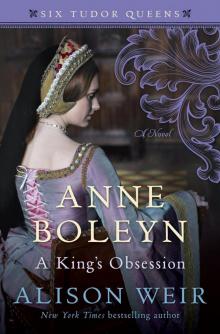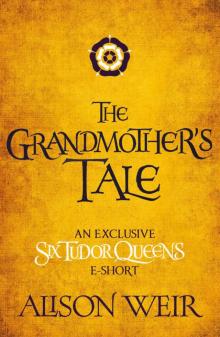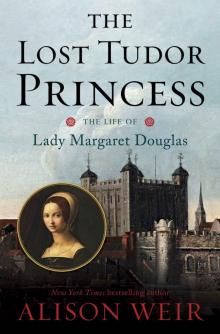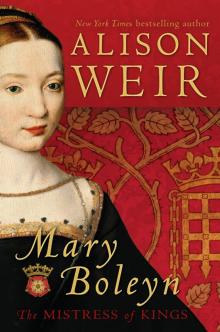- Home
- Alison Weir
Elizabeth of York Page 3
Elizabeth of York Read online
Page 3
The King bought his wife a jeweled ornament costing £125 [£62,550] “against the birth of our most dear daughter Elizabeth.” Even though she had only borne a daughter, Elizabeth Wydeville’s churching ceremony that followed in late March was attended by great magnificence. The Queen left her childbed that morning and went to church in stately order, accompanied by many priests bearing relics and by many scholars singing and carrying lights. There followed a great company of ladies and maidens from the country and from London. Then came trumpeters, pipers, and players of stringed instruments. The King’s choir followed, forty-two of them, who sang excellently. Then came twenty-four heralds and pursuivants, followed by sixty earls and knights. At last came the Queen, escorted by two dukes. Above her was a canopy. Behind her were her mother and maidens and ladies to the number of sixty. Then the Queen heard the singing of an office. Following the service of purification that marked her return to society after her confinement, “she returned to the palace in procession, as before. Then all who had joined the procession remained to eat.” So many guests were present—clearly a prince had been anticipated—that they “filled four great rooms” of an “unbelievably costly apartment.”6
Elizabeth Wydeville might have been deemed an unsuitable bride for the King, but she was determined that no one should remember it, and the etiquette that surrounded her on this occasion was rigorous. “The Queen sat alone at table on a costly golden chair. The Queen’s mother and the King’s sister [Anne, Duchess of Exeter] had to stand some distance away. When the Queen spoke with her mother or the King’s sister, they knelt down before her until she had drunk water. Not until the first dish was set before the Queen could [they] be seated. The [sixty] ladies and maidens and all who served the Queen at table were of noble birth, and had to kneel so long as the Queen was eating; the meal lasted for three hours. The food which was served to the Queen, the Queen’s mother, the King’s sister, and others was most costly. Everyone was silent and not a word was spoken.” Afterward, no doubt to everyone’s relief, there was dancing, with the ladies curtseying elegantly to the silent Queen, and glorious singing by the King’s choristers. A foreign observer noted: “The courtly reverence paid to the Queen was such as I have never seen elsewhere.”7
Like all babies in those days, the infant princess was swaddled in tight bands with a close-fitting cap on her head, and she would have remained swaddled for the first eight or nine months of her life to ensure that her limbs grew straight. She was assigned a stately household that included a nurse (each of the royal children had a separate nurse) and a wet nurse, for queens did not suckle their children. The household was under the charge of a lady mistress, or governess, Margaret, Lady Berners,8 who received a salary of £100 [£50,000]. Under her were pages of the chamber, a “knight of the trencher,” and rockers to watch over the princess in her cradle.
The kingdom into which Elizabeth of York was born was a land of prosperity, according to an Italian observer writing in 1500: “The riches of England are greater than those of any other country in Europe. This is owing, in the first place, to the great fertility of the soil, which is such that, with the exception of wine, they import nothing from abroad for their subsistence.” The export of tin brought large sums into the realm, “but still more do they derive from their extraordinary abundance of wool. And everyone who makes a tour in the island will soon become aware of this great wealth, for there is no small innkeeper, however poor and humble he may be, who does not serve his table with silver dishes and drinking cups, and no one who has not in his house silver plate to the amount of £100 [£50,000]. But above all are their riches displayed in the church treasures … You may therefore imagine what the decorations of these enormously rich Benedictine, Carthusian, and Cistercian monasteries must be. These are, indeed, more like baronial palaces than religious houses.”9 And all, of course, would be swept away within seventy years of Elizabeth’s birth, on the orders of her son. But for now, England was celebrated as “the ringing isle” because of its many churches, abbeys, and priories.
Much more of the land was covered by forest and woodland than it is now. The country was largely rural and given over to agriculture; as the Italian perceived, it had become prosperous through the export of wool and, latterly, woolen cloth. The people were often turbulent, unruly, and vociferous—especially when it came to new taxes—and it was said that while the French vice was lechery, the English vice was treachery. The latter were perceived to be lazy—“it is received as a prescript that they should sweat by no means”—and gluttonous: “though they live in hovels, they eat like lords.” Most people lived in the country, and society was generally localized. It was the upper classes and merchants who traveled.
Elizabeth would have learned early in life that she was a very special little girl. Her father was the King, whose person was regarded as sacred. Divinely appointed to rule, he had been invested at his coronation with a sanctity that set him apart from ordinary mortals and bestowed on him the grace to govern with a wisdom denied to others. The royal prerogative was believed to be the will of God working through the will of the King.
The court over which King Edward presided, and in which Elizabeth grew up, was a magnificent one—“the most splendid court that could be found in all Christendom.”10 The royal family was its central focus, so Elizabeth would have grown up with a sense of her importance in the world. It would have seemed a crowded world to a young child—Edward IV’s household numbered about eight hundred persons or more, not counting the members of his queen’s separate establishment. The court was itinerant, with the King dividing his time between a dozen of his palaces (most of them in the Thames Valley), according to the demands of state, the hunting to be had, or the need for cleansing a house after hundreds of courtiers and servants had tested its capacity for drainage to the limits.
Elizabeth would have become used to travel from infancy. The royal household would regularly wend its cumbersome way about the country, taking with it a long train of servants, carts, and packhorses laden with furniture, tapestries, personal belongings, and state papers, all packed in chests, coffers, and bags. The royal women and children traveled either by barge—the Thames being the main highway through London—or in covered horse-drawn coaches, like wagons, with four wheels, which could not have been very comfortable, as they were unsprung; or in smaller versions called litters, chariots, or “chairs.” A household could travel an average of twenty-six miles a day, depending on the state of the roads. Most were little more than tracks, with a few surviving Roman exceptions, and their condition depended on the weather and the public-spiritedness of the parish authorities or landowners who were supposed to maintain them. It was for this reason that royalty often preferred, where possible, to travel by river.
In his tastes, King Edward followed the dictates of the court of Burgundy, which at that time led the rest of northern Europe in art, architecture, style, dress, manners, and court ceremonial. He understood the value of magnificence that underpinned Burgundian court culture, and spent lavishly on clothing, jewels, plate, and tapestries from the Low Countries, but it was not until later in his reign that he was able to patronize the arts and indulge his passion for building. Today, the Perpendicular-style glory of St. George’s Chapel, Windsor, and the great hall at Eltham Palace, bear witness to the largely vanished splendors of his reign.
Elizabeth grew up to know these places well, especially the Palace of Westminster. Opposite stood Westminster Abbey, where kings were crowned and many of her royal forebears were buried. Elizabeth would have grown up knowing the neighboring City of London well too. “All the beauty of this island is confined to London,” wrote the anonymous Italian in 1500.11 It was one of the greatest cities in Christendom, prosperous and teeming, its skyline dominated by the soaring Gothic edifice of St. Paul’s Cathedral and the spires of over eighty churches. About 60,000 to 75,000 of England’s estimated population of three or four million people lived in the City, which possessed “all the a
dvantages to be desired in a maritime town” and was a flourishing mercantile center. “On the banks of the Thames are enormous warehouses for imported goods; also numerous cranes of remarkable size to unload merchandise from ships … Whatever there is in the City, it all belongs to craftsmen and merchants,”12 such as would supply Elizabeth with luxury goods all her life.
In buildings of timber or brick, “the Londoners live comfortably.” The City abounded “with every article of luxury, as well as with the necessaries of life. In a single street, named the Strand, there are fifty-two goldsmiths’ shops.” This was especially remarkable to a foreigner because the citizens were not noblemen or gentlemen, but “persons of low degree and artificers,”13 many made wealthy by trade. The City authorities were fiercely protective of their liberties.
Around 1500, the Scots poet William Dunbar was so impressed by London, “sovereign of cities,” that he wrote a long poem in praise of it, of which this is an extract:
Strong be thy walls that about thee stand;
Wise be the people that within thee dwell;
Fresh be thy river with his lusty strands;
Blithe be thy churches, well sounding be thy bells;
Rich be thy merchants in substance that excels;
Fair be their wives, right lovesome, white and small;
Clear be thy virgins, lusty under kirtles;
London, thou art the flower of cities all.
The luxurious court in which the princess grew up was dominated by two opposing factions: Warwick and the Wydevilles. The latter, and their connections, were especially prominent in the Queen’s household, and their influence on the young Elizabeth and her siblings should not be underestimated.
Her mother, Queen Elizabeth, was confounding her critics and adapting to her role with grace and dignity. In every respect but her background she was a model consort. As the years passed, she proved that she could fulfill her royal duties as well as any born princess and use her influence in beneficial ways. She was pious and charitable; she ran her household efficiently and lived within her means. She enjoyed the King’s absolute trust, and, having resolved to turn an unseeing eye to his many infidelities, she retained his respect and affection. Thus she was highly influential behind the scenes—and it was this that Warwick and others continued to resent, along with the power enjoyed by her kinsmen.
Not since the aggrandizement of the Savoyard relatives of Henry III’s unpopular consort, Eleanor of Provence, in the thirteenth century, had the English court witnessed such large-scale promotion of a queen’s relations.14 For the King was advancing his legion of in-laws by securing for them the best matches the aristocracy could offer. He built up the power of the Wydevilles by these marriages, and by bestowing on them titles and offices, while the Queen “attracted to her party many strangers, and introduced them to court, so that they alone should manage the public and private business of the crown” through their power to “give or sell offices, and rule the very King himself.”15 That power was steadily increasing, “to the exaltation of the Queen and the displeasure of the whole realm.”16 While some nobles were eager to mate with the new queen’s relations, seeing such marriages as a means to advancement and royal favor, others—especially Warwick—were scandalized and resentful, for they regarded the Wydevilles as too lowborn for such honors17 and influence, which was then considered the privilege of the nobility, not of upwardly mobile parvenus.
Naturally, the Queen was blamed for leading the King astray; she was seen as grasping and interfering, and responsible for the aggressive promotion of her relations and their undue influence with Edward. The Duke of Milan was informed that, “since her coronation, [the Queen] has always exerted herself to aggrandize her relations. She has five brothers and as many sisters, and has brought things to such a pass that they have the entire government of this realm, to such an extent that the rest of the lords about the government were one with the Earl of Warwick, who has always been great, and deservedly so.”18 Even though there may have been some exaggeration in foreign reports of the 1460s, twenty years later we find that the Wydevilles were still “detested by the nobles because they, who were ignoble or newly made, were advanced beyond those who far excelled them in breeding and wisdom,”19 a viewpoint in keeping with the social and cultural sensibilities of the age.
The unpopularity of the Wydevilles centered chiefly upon the aggrandizement of the Queen’s father and elder brothers (and later her sons by her first marriage), which led to the whole family being vilified. Yet the Wydevilles were not without virtues or political strengths, even if they were rapacious. Of Elizabeth’s uncles, Anthony, the Lord Treasurer of England, was an erudite man of many talents, and Lionel, who became Bishop of Salisbury, was an Oxford-educated canon lawyer.
The power of the Wydevilles was everywhere acknowledged. Appearing one day in 1469 equipped with walking boots and a staff, King Edward’s fool jested to his master’s face, “Upon my faith, sir, I have passed through many countries of your realm, and in places that I have passed the Rivers have been so high that I could barely scape through them!”20 Yet the Wydeville men were loyal to Edward IV and served him well in the various capacities to which he appointed them; and they did not dominate in his counsels to the exclusion of all others, for Warwick, William, Lord Hastings, and John Howard, Duke of Norfolk, remained highly influential in Edward’s inner circle of advisers.
Elizabeth’s grandparents were an attractive couple. Lord Rivers had been “renowned for being the most handsome knight in England”21 and Jacquetta of Luxembourg was “an exceedingly handsome gentlewoman.”22 She had retained her title and rank, and remained first lady in the land until Henry VI married Margaret of Anjou in 1445. She had borne Wydeville sixteen children, of whom Queen Elizabeth was the eldest. During the first phase of the Wars of the Roses, the Wydevilles had naturally supported the House of Lancaster: Lord Rivers and his eldest son, Anthony, had fought for Henry VI at Towton. After Edward IV became King in 1461, they speedily changed sides, and Edward pardoned Rivers for “all manner of offenses and trespasses done against us.” Jacquetta, Duchess of Bedford, was frequently at court during Elizabeth’s childhood, so the princess must have come to know her grandmother well.
She probably grew up with only dim memories of her maternal grandfather, Richard Wydeville, who died when she was three. He had been created Earl Rivers in the year of her birth, to “the displeasure of the whole kingdom.”23 Having distinguished himself fighting in France under Henry V and Bedford, he had since risen high on his own abilities. Yet his enemies never allowed this man whom Warwick’s father had sneeringly called “knave’s son” to forget his humble origins, and there were accusations that he had been “made by marriage.”24 His reputation was compounded by his being rapacious and vengeful, and he was not above using extortion to get what he wanted.
Elizabeth Wydeville was to bear the King ten children. On August 11, 1467, at Windsor Castle, she was delivered of the second, another daughter, Mary, fair-haired and blue-eyed.25 The Queen’s mother, the Duchess of Bedford, came to court to assist at the lying-in. The new princess was baptized at Westminster in the presence of the French ambassador, with Thomas Bourchier, Archbishop of Canterbury, acting as one of the sponsors.
On October 9, 1467, at Westminster, the King granted “for life” to his twenty-month-old elder daughter, “the Princess Elizabeth, the manor of Great Linford, county of Buckingham, lately belonging to James [Butler], Earl of Wiltshire, and in the King’s hands.”26 Butler had been executed in 1461 and his titles confiscated to the crown. It is unlikely that Elizabeth ever visited Great Linford; the King would have assigned it to her so that the manor rents could maintain her during her childhood. She held it until 1474, when it was sold to Gerard Caniziani, a London merchant.27
The manor of Sheen, a royal palace in Surrey, had been granted to the Queen in 1467, for life, probably as a nursery for her children, and by October 9, 1468, the two little princesses, Elizabeth and Mary, were li
ving at Sheen Palace in the care of Margery, Lady Berners, their lady mistress. On that date, the Queen was granted £400 per annum [£200,200] for their expenses until such time as they married.28
The Italian visitor was not the only foreigner struck by “the want of affection strongly manifested” by the English toward their children; “for everyone, however rich he be, sends his children into the houses of others … And on inquiring the reason for the severity, they answered that they did it in order that their children might learn better manners.”29 There was some concept of the innocence of childhood, but fifteenth-century parents were more concerned about civilizing their children and preventing them from falling into sin and wantonness; they recognized that mothers might not be as strict as others less close to their children: “let not the feminine pity of your wives destroy your children, and pamper them not at home … Dandle them not too dearly lest folly fasten on them.”30 There were also, of course, many advantages to be gained from placing offspring in great establishments, even as apprentices.
Royal children were not sent into noble households, as aristocratic children were, but at an early age were assigned households of their own, away from the court, and their day-to-day upbringing was supervised, not by their parents, but by the lady mistress. Giving royal children separate establishments not only reflected the magnificence of a ruler, but protected his infant offspring from the health hazards they risked in London and the court. Nursery palaces were usually outside the City “because, the air [in the country] being somewhat at large, the place is healthy; and the noise not so much, and so consequently quiet.”31

 Richard III and the Princes in the Tower
Richard III and the Princes in the Tower Britain's Royal Families: The Complete Genealogy
Britain's Royal Families: The Complete Genealogy The Lady in the Tower: The Fall of Anne Boleyn
The Lady in the Tower: The Fall of Anne Boleyn Six Wives of Henry VIII
Six Wives of Henry VIII Elizabeth of York: A Tudor Queen and Her World
Elizabeth of York: A Tudor Queen and Her World Captive Queen
Captive Queen Innocent Traitor
Innocent Traitor The Marriage Game
The Marriage Game A Dangerous Inheritance
A Dangerous Inheritance Katherine of Aragón: The True Queen
Katherine of Aragón: The True Queen The Marriage Game: A Novel of Queen Elizabeth I
The Marriage Game: A Novel of Queen Elizabeth I Princes in the Tower
Princes in the Tower Anne Boleyn: A King's Obsession
Anne Boleyn: A King's Obsession Traitors of the Tower
Traitors of the Tower Mistress of the Monarchy: The Life of Katherine Swynford, Duchess of Lancaster
Mistress of the Monarchy: The Life of Katherine Swynford, Duchess of Lancaster Queens of the Conquest: England’s Medieval Queens
Queens of the Conquest: England’s Medieval Queens Eleanor of Aquitaine: A Life
Eleanor of Aquitaine: A Life Mary, Queen of Scots, and the Murder of Lord Darnley
Mary, Queen of Scots, and the Murder of Lord Darnley Henry VIII: The King and His Court
Henry VIII: The King and His Court Queen Isabella: Treachery, Adultery, and Murder in Medieval England
Queen Isabella: Treachery, Adultery, and Murder in Medieval England Katheryn Howard, the Scandalous Queen
Katheryn Howard, the Scandalous Queen Arthur- Prince of the Roses
Arthur- Prince of the Roses The Wars of the Roses
The Wars of the Roses Eleanor of Aquitaine: By the Wrath of God, Queen of England
Eleanor of Aquitaine: By the Wrath of God, Queen of England Mary Boleyn: The Great and Infamous Whore
Mary Boleyn: The Great and Infamous Whore Jane Seymour: The Haunted Queen
Jane Seymour: The Haunted Queen Anna of Kleve, the Princess in the Portrait
Anna of Kleve, the Princess in the Portrait Lancaster and York: The Wars of the Roses
Lancaster and York: The Wars of the Roses The Grandmother's Tale
The Grandmother's Tale The Princess of Scotland (Six Tudor Queens #5.5)
The Princess of Scotland (Six Tudor Queens #5.5) The Lady Elizabeth
The Lady Elizabeth Katherine Swynford: The Story of John of Gaunt and His Scandalous Duchess
Katherine Swynford: The Story of John of Gaunt and His Scandalous Duchess The Curse of the Hungerfords
The Curse of the Hungerfords The Lost Tudor Princess: The Life of Lady Margaret Douglas
The Lost Tudor Princess: The Life of Lady Margaret Douglas Eleanor of Aquitaine
Eleanor of Aquitaine Mistress of the Monarchy
Mistress of the Monarchy The Lost Tudor Princess
The Lost Tudor Princess Henry VIII
Henry VIII Anne Boleyn, a King's Obsession
Anne Boleyn, a King's Obsession A Dangerous Inheritance: A Novel of Tudor Rivals and the Secret of the Tower
A Dangerous Inheritance: A Novel of Tudor Rivals and the Secret of the Tower Elizabeth of York
Elizabeth of York Katherine of Aragon, the True Queen
Katherine of Aragon, the True Queen Katherine Swynford
Katherine Swynford Wars of the Roses
Wars of the Roses Queens of the Conquest
Queens of the Conquest Mary Boleyn
Mary Boleyn Britain's Royal Families
Britain's Royal Families The Tower Is Full of Ghosts Today
The Tower Is Full of Ghosts Today Life of Elizabeth I
Life of Elizabeth I Anne Boleyn A King's Obssession
Anne Boleyn A King's Obssession Lancaster and York
Lancaster and York Jane Seymour, the Haunted Queen
Jane Seymour, the Haunted Queen Queen Isabella
Queen Isabella The princes in the tower
The princes in the tower